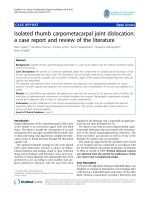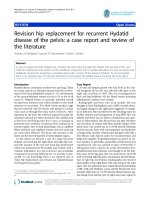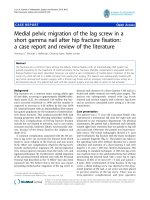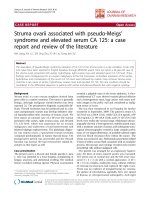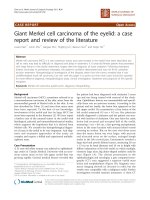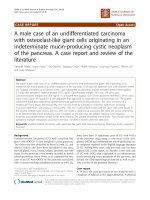Sinonasal desmoplastic small round cell tumor: A case report and review of the literature
Bạn đang xem bản rút gọn của tài liệu. Xem và tải ngay bản đầy đủ của tài liệu tại đây (750.99 KB, 5 trang )
Tao et al. BMC Cancer
(2019) 19:868
/>
CASE REPORT
Open Access
Sinonasal desmoplastic small round cell
tumor: a case report and review of the
literature
Yanli Tao1,2†, Lina Shi3†, Li Ge4, Tiejun Yuan2 and Li Shi1*
Abstract
Background: Desmoplastic small round cell tumor (DSRCT) is a rare malignancy with poor prognosis that generally
involves the peritoneum. Its diagnosis can be achieved only by immunohistochemistry and cytogenetic studies.
Case presentation: In the current report, a 55-year-old female was admitted in our hospital for evaluation of right
eye epiphora and right nasal intermittent bleeding. Imaging examination revealed a large soft tissue mass in the
right nasal cavity and ethmoid sinus. After an explorative surgery, the pathological findings confirmed the
presentation of sinonasal DSRCT. Immunohistochemistry and cytogenetic studies confirmed the diagnosis of DSRCT
in this patient. Surgical resection, chemotherapy, and radiotherapy was performed, and she died 2 months after
operation.
Conclusion: This reported case draws attention to the importance of novel treatments and including DSRCT in the
differential diagnosis of sinonasal tumors.
Keywords: Desmoplastic small round cell tumor, Surgical resection, Multimodal management
Background
Desmoplastic small round cell tumor (DSRCT) is a rare
and aggressive mesenchymal malignancy. Only 850 such
patients were reported in the medical literature [1]. First
described in 1989 [2, 3], DSRCT’s name derives from its
distinctive histological findings, which include clusters of
undifferentiated, small round blue cells surrounded by
abundant desmoplasia.
Patients with DSRCT are usually between 5 and 30 years
of age. Males and older adolescents are more often affected
[4, 5]. The most commonly affected region is the pelvis,
other sites mainly include the omentum, the spatium retroperitoneale and the mesentery [6–8]. Tumors located in the
abdomen or pelvis generally require a period of growth before they can cause symptoms of the body. When the symptoms of the body appear, it is usually atypical, mainly
characterized by abdominal pain, weight loss, abdominal
* Correspondence:
†
Yanli Tao and Lina Shi contributed equally to this article thus shared the cofirst authors.
1
Department of Otolaryngology, The Second Hospital of Shandong
University, 247#, Beiyuan Street, Jinan 250033, China
Full list of author information is available at the end of the article
fullness, etc. Therefore, DSRCT is often diagnosed when the
tumor has metastasized or is in the advanced stage of the
disease. According to the SEER database, only about onefifth of patients are diagnosed with only localized disease [4].
In spite of great advances in medical technology, the
treatment of DSRCT remains a challenge for doctors.
There are currently no standardized treatment approaches.
Surgical resection combined with chemotherapy and radiotherapy are the main treatment methods at present [5]. Surgery is currently the best treatment option. The 3-year
survival rate for complete tumor resection cases was reported to be 58%, compared to 0% in unresectable cases
[9]. However, surgery does not produce any benefit for patients with extraperitoneal metastases [10]. DSRCT still has
a poor prognosis despite these multimodal treatments, with
a 3-year survival rate of less than 30% and a 5-year survival
rate of only 18% [11, 12]. Therefore, novel therapy is
required.
We present a recent case of sinonasal DSRCT and review the literature. The purpose of this study is to describe the microscopic patterns and cytological criteria
as well as to describe our experience in the diagnosis
and treatment of DSRCT.
© The Author(s). 2019 Open Access This article is distributed under the terms of the Creative Commons Attribution 4.0
International License ( which permits unrestricted use, distribution, and
reproduction in any medium, provided you give appropriate credit to the original author(s) and the source, provide a link to
the Creative Commons license, and indicate if changes were made. The Creative Commons Public Domain Dedication waiver
( applies to the data made available in this article, unless otherwise stated.
Tao et al. BMC Cancer
(2019) 19:868
Case presentation
A 55-year-old female was admitted in our hospital for
right eye epiphora and right nasal intermittent bleeding
on August 2018. Nasal endoscopy revealed a right nasal
mass located in the middle nasal meatus. A magnetic resonance imaging (MRI) and computed tomography (CT)
scans showed a large soft tissue masse in the right nasal
cavity and ethmoid sinus, which invaded the right lamina
papyracea, the right frontal sinus and the right side of
nasal septum. The medial wall of the right superior collar
sinus, middle turbinate and part of ethmoid sinus septum
were accompanied by erosive bone resorption (Fig. 1a-b).
Swollen lymph nodes can be seen in the right neck. The
patient underwent endoscopic biopsy of the right ethmoid
sinus and pathological examination. Fragments of soft to
firm gray and tan tissue were submitted for pathologic
examination. The sinus tumors in the right nasal cavity
were resected under nasal endoscope.
Diagnosis required confirmation of histopathological
features, polyphenotypic immunohistochemical reactivity, and molecular/cytogenetic findings [13], therefore
the following experiments were performed.
Histopathological manifestations
Under the light microscope, the lesions were composed of
irregular lamellae and nested tumor cells and the surrounding fibrous interstitial cells. The tumor cells in the
nest are small round or oval, with few cytoplasm, unclear
cell boundaries, round or oval hyperchromatic nuclei, unclear nucleoli, and mitotic figures were easy to observe
(Fig. 2a-b). The stroma is a proliferative dense fibrous connective tissue composed of fibroblasts and myofibroblasts
with mucoid degeneration. In this case, the tumors invaded bone.
Fig. 1 Imaging changes of the patient before surgery. Large soft
tissue mass located in the right nasal cavity and ethmoid sinus,
invading the right lamina papyracea, right frontal sinus, right side of
the nasal septum. The medial wall of right maxillary sinus, the
ethmoid cornua, and part of the ethmoid sinus were observed with
erosional bone resorption and destruction
Page 2 of 5
Immunohistochemical staining
Immunohistochemistry gave the following phenotypic
markers: CD56 (+) (Fig. 2c), Vimentin (+), WT-1 (+)
(Fig. 2d), S-100(−), Desmin (−), CD99 (−), with a Ki-67
index of 95% (Fig. 2e). Vim showed characteristic dotlike perinuclear staining pattern (Fig. 2f), and did not express EMA, Desmine, S-100, MyoDl, CD20, CD3, CD7
and P63.
Bone marrow puncture results
Blood smear: There is no obvious increase or decrease
of white blood cells, neutrophils are almost normal, and
middle and late red blood cells account for 6/100 nucleated cells, and platelets are scattered. (Fig. 2g).
Bone marrow smear: Bone marrow proliferation was active, G = 49.0%, E = 21.0%, G/ E = 2.33:1. The main stage of
granulocytes was below the middle and young granulocytes,
with no obvious morphological abnormalities. All stages of
the erythroid system were noticed, there was no obvious
abnormality in morphology, and the size of mature red
blood cells was uneven. The cancer cells were scattered or
clustered. Their cell bodies were large, the boundaries were
unclear, round or irregular, with a large amount of cytoplasm, stained with purple-blue or purple-red, partially
foamy, with large nuclei and chromatin accumulation.
Naked nuclear tumor cells were frequently observed. Plasmacytes and histiocytes were easy to observe. No megakaryocytes and thrombocytopenia were found in the whole
smear. (Fig. 2h).
Treatment and outcome
During the operation, a small part of the tumors were removed by forceps and sent for rapid frozen pathological
diagnosis. The results showed that the tumors were small
cell malignant tumors. After the uncinate process was removed, the maxillary sinus was opened and the purulent
secretions in the maxillary sinus were sucked out. The
maxillary sinus orifice and the medial wall of the maxillary
sinus were removed and sent to pathology. The pathological results showed that the orbital cardboard was partially absorbed. Then the orbital cardboard and the orbital
fascia were fully separated and removed. After resection of
the right frontal sinus mass, the right middle turbinate
was removed. It was found that the nasal cavity mass was
grey-white fish-like and invaded the right frontal sinus,
the right orbital cardboard and the medial wall of the right
maxillary sinus. The orbital fascia was intact. Postoperative pathology showed that the tumors were found in the
right orbital wall, the right maxillary sinus wall, the posterior wall, the posterior inferior wall and the right middle
turbinate root. Chemotherapy and radiotherapy was performed, but the patient was found to have bone marrow
metastasis and presented with persistent nasal bleeding
and she died 2 months after operation.
Tao et al. BMC Cancer
(2019) 19:868
Page 3 of 5
Fig. 2 a-b HE morphology of the patient. Tumor cells were irregular sheet-like and nest-like distribution, surrounded by proliferative fibrous
stroma. The tumor cells in the nest are small round or oval, with few cytoplasm, unclear cell boundaries, round or oval hyperchromatic nuclei,
unclear nucleoli, and mitotic figures were easy to observe (10× and 40×). c-d Desmoplastic small round cell tumor shows immunoreactivity for
CD56 (40×) and WT-1 (40×). e Desmoplastic small round cell tumor shows positive Ki-67 with an index of 95% (40×). f Vim stain revealed the
characteristic dot-like perinuclear pattern (40×). g Blood smear showed no obvious increase or decrease of white blood cells, normal neutrophils,
and middle and late red blood cells account for 6/100 nucleated cells, and platelets were scattered. h Bone marrow smear image. The cancer
cells were scattered or clustered. Their cell bodies were large with unclear boundaries and a large amount of cytoplasm, stained with purple-blue
or purple-red, partially foamy, with large nuclei and chromatin accumulation. Naked nuclear tumor cells were frequently observed
Discussion and conclusion
DSRCT usually occurs between 5 and 50 years with an average age of 22 years. In general, nearly 85–90% of patients are
male, but in patients younger than 20 years old at the time
of diagnosis, the proportion of females is slightly higher [9].
The clinical manifestations of DSRCT are not typical, and
patients often experience abdominal or pelvic discomfort,
typically including abdominal pain and/or bloating, ascites,
constipation, and urinary tract disease [14–16].
DSRCT, which occurs in the nasal cavity and sinuses, is
extremely rare, and only two cases reported in the literature were retrieved on PubMed, their clinical features,
treatment and outcomes were summarized in Table 1. Its
clinical manifestations are complex and varied. Generally,
local symptoms occur according to different parts of the
body, without its own unique clinical manifestations. If it
occurs in the abdominal cavity or pelvic cavity, clinical
manifestations are usually abdominal pain, abdominal distension or abdominal mass, which can be accompanied by
cachexia such as fever, anemia, emaciation, and prone to
substantial organs and lymph node metastasis; while in
the nasal cavity and paranasal sinuses, the primary symptoms are mainly sinusitis, nosebleeds and nasal congestion, local infiltration and cervical lymph node metastasis
may occur, and small round cell malignant swelling is
common in this area. The clinical manifestations of the
tumors were not significantly different, and it was difficult
to make a definite diagnosis in clinic.
Despite multimodal therapy, patients with DSRCT overall
have very poor survival rates of 15–30% at 5 years [4, 5].
The case in this report died 2 months after surgery because
of bone marrow metastasis of the tumor, which may be one
of the reasons for the poor prognosis in the current case
compared with the cases reported in the literature.
The majority of desmoplastic small round cell tumors
can be reliably diagnosed based on the characteristic
morphology and immunohistochemical profile. Most literatures reported that DSRCT cells expressed epithelial,
mesenchymal and neuroendocrine markers [19]. However,
some reports showed that the immunophenotype of some
Table 1 Case reports of sinonasal desmoplastic small round cell tumors reported in the literature
Author
Age (y),
Gender
Main symptom
Tumor location
Treatment
Patient outcome at
time of report
Present
study
55, F
Right eye epiphora, right nasal
intermittent bleeding
Right ethmoidal sinus, frontal sinus
and lamina papyracea
Tumor resection
Survival of 12 mo
Fink MD. et 21, F
al. [17]
Chronic sinusitis
Frontal, ethmoidal and sphenoid
sinus
Tumor resection;
Survival of more
Radiotherapy; Chemotherapy than 26 mo
LOPEZ F. et 61, M
al. [18]
Stuffy and bleeding of right-side Right ethmoidal sinus and anterior
nose occasionally
cranial fossa
F Female, M Male
Tumor resection;
Radiotherapy
Survival of more
than 29 mo
Tao et al. BMC Cancer
(2019) 19:868
Page 4 of 5
DSRCTs were atypical, only expressed Vim, CD56 and
other markers, but did not express epithelial and neurogenic or myogenic markers [20]. Des and NSE were not
expressed in this case, but only Vim, CD56 and WT-1
markers, which made it difficult to diagnose and differential diagnose. Therefore, familiarity with the characteristic
immunophenotypes and molecular pathological changes
of DSRCT will be helpful in differential diagnosis.
Due to its histological similarities with other malignant
‘small’ round cell tumors, DSRCT has been confused histologically with other lesions, including primary olfactory
neuroblastoma [21], small-cell anaplastic carcinoma and
Ewing sarcoma /primitive neurotodermal tumor (PENT).
Olfactory neuroblastoma usually occurs in olfactory cleft.
Comparison between DSRCT and other small round cell
tumors were shown in Table 2. Neurogenic markers such
as NSE and synaptic vesicle protein were strongly positive
in tumor cells, while low molecular weight keratin was
weakly expressed in only a few cases. Myogenic and epithelial antigens were not expressed and S100 was expressed in
sertoli cells around the tumor nest. These clinical and
pathological features as well as molecular pathological
examination are helpful in differentiating DSRCT. Secondly, it is necessary to identify small-cell anaplastic carcinoma. The tumor cells express epithelial markers, partially
express neuroendocrine markers, but lack obvious multidirectional differentiation, do not express myogenic
markers, and have few interstitial. The dot-like expression
of Vim in DSRCT tumor cells is of great value in differential diagnosis [22]. The third is extraosseous Ewing sarcoma
/primitive neurotodermal tumor (PENT), which is predominantly located in the lower extremities, spine, retroperitoneum and pleura. It can also occur in the nasal cavity and
paranasal sinuses. Its onset age, histological morphology,
immunophenotype and molecular pathological changes
overlap with DSRCT to a certain extent. When Ewing sarcoma /PENT tumors contain a large amount of fibrous
connective tissue, it is very easy to be misdiagnosed as
DSRCT [23]. However, the former generally does not express epithelial or myogenic markers, CD99 is strongly
Table 2 Comparison between DSRCT and other small round cell tumors
Item
DSRCT
Extraosseous Ewing’s
sarcoma/primitive
neuroectodermal tumors
(PNET)
Olfactory neuroblastoma
Morphological
characteristics
Nests of small round cells
vary in size and shape, and
there are a large number of
fibrous connective tissue
stroma between the nests of
tumor cells. Tumor cells are
closely arranged, thin and
sparse, with unclear cell
boundaries, round or oval
nuclei, hyperchromatic nuclei,
unclear nucleoli, and mitotic
figures are easy to see
Round cells are compactly
patchy/lobular, and
fibrovascular septa are
observed between lobules
with varying width of fibrous
connective tissue. The
cytoplasm of the tumor cells
is scarce and unclear, but
some of the cytoplasmic
margins could be bright or
vacuolar. The nuclei are
round/oval, dark-stained/
uniform pepper-salt-like, and
the mitotic figures vary.
Round cells are nested/
Small round cells without
lobulated, and interlobular
specific morphology
spaces are vascular-rich
fibrous connective tissue.
Tumor cells differentiate in
different degrees. The welldifferentiated nuclei of tumor
cells have no obvious atypia,
fine chromatin, no obvious
nucleoli, few mitotic images
and more nerve fiber
networks in the interstitium.
The poorly differentiated
tumors have obvious nuclear
atypia, easily seen mitotic
images, few/absent interstitial
fibrous networks and a large
number of necrosis.
Immunohistochemistry Multidirectional differentiation
and positive expression:
epithelial marker,
neuroendocrine marker, WT-1,
Desmin (paranuclear point
positive), Vimentin
(paranuclear point positive);
negative: CD99
Positive expression: CD99,
Vimentin, CyclinD1;
Different degrees of
expression: neuroendocrine
markers;
No expression: epithelial
markers, WT-1, Desmin, S-100,
NF
Positive expression:
neuroendocrine markers
(such as NSE, Syn), NF, GFAP,
S-100 (sertoli cells around the
cancer nest +), epithelial
markers (a few weak
expression of low molecular
keratin);
No expression: Desmin, EMA,
CD99
Positive expression: epithelial
markers; Partial expression of
neuroendocrine markers;
lack of multidirectional
differentiation; Negative
expression: Desmin et al.
Molecular pathology
EWS-WT1 gene fusion
EWS-FLI-1 gene fusion
No specific molecular
changes
No specific molecular
changes
Clinical features
> 95% occurred in pelvic and
abdominal cavity, < 5% in
paranasal sinuses, pleura,
testis, intracranial, liver, lung,
mediastinum, ovary, pancreas,
etc
Usually occurs in lower limbs,
spine, retroperitoneum,
pleura, etc. and can also
occur in nasal cavity and
paranasal sinuses
Prevalent in upper turbinate,
ethmoidal plate, upper third
of nasal cavity (usually in
olfactory cleft)
Can occur in all parts of the
body
Small cell undifferentiated
carcinoma
Tao et al. BMC Cancer
(2019) 19:868
positive, and the molecular pathological changes are EWSFLI1 gene fusion. These features can help differential
diagnosis. In this case, WT-1 (+), CD99 (−) can exclude
extraosseous Ewing sarcoma and neuroblastoma.
In summary, this reported case of DSRCT emphasizes
the importance of incorporating DSRCT in the differential diagnosis of sinonasal tumors. And our study demonstrates the value of imunohistochemical analysis and
molecular studies during the diagnosis of tumors which
occur in an unusual location.
Page 5 of 5
5.
6.
7.
8.
9.
Abbreviations
CT: Computed tomography; DSRCT: Desmoplastic small round cell tumor;
MRI: Magnetic resonance imaging; PENT: Primitive neurotodermal tumor
10.
Acknowledgments
Not applicable.
11.
Authors’ contributions
Conception and design, SL; Data collection, TY and SLN; Data analysis and
Manuscript preparation, TY, SLN, GL and YT. And all authors read and
approved the final version of the manuscript and ensure this is the case.
12.
13.
Funding
Not applicable.
14.
Availability of data and materials
All data generated or analyzed during this study are included in this
published article.
15.
16.
Ethics approval and consent to participate
The study was approved by the ethic committee of The Second Hospital of
Shandong University and Weifang People’s Hospital.
Consent for publication
Written informed consent was obtained from the patient’s son for
publication of this case report and any accompanying images. A copy of the
written consent is available for review by the Editor of this journal.
Competing interests
The authors declare that they have no competing interests.
Author details
1
Department of Otolaryngology, The Second Hospital of Shandong
University, 247#, Beiyuan Street, Jinan 250033, China. 2Department of
Otolaryngology, Weifang People’s Hospital, No. 151, Guangwen Street,
Kuiwen District, Weifang 261000, China. 3Shandong Provincial Key Laboratory
of Oral Tissue Regeneration, Department of Bone Metabolism, School of
Stomatology, Shandong University, Wenhua West Road 44-1, Jinan 250012,
China. 4Department of Pathology, Weifang People’s Hospital, No. 151,
Guangwen Street, Kuiwen District, Weifang 261000, China.
17.
18.
19.
20.
21.
22.
23.
Hayes-Jordan A, LaQuaglia MP, Modak S. Management of desmoplastic
small round cell tumor. Semin Pediatr Surg. 2016;25(5):299–304.
Zhang WD, Li CX, Liu QY, Hu YY, Cao Y, Huang JH. CT, MRI, and FDG-PET/CT
imaging findings of abdominopelvic desmoplastic small round cell tumors:
correlation with histopathologic findings. Eur J Radiol. 2011;80(2):269–73.
Kis B, O'Regan KN, Agoston A, Javery O, Jagannathan J, Ramaiya NH.
Imaging of desmoplastic small round cell tumour in adults. Br J Radiol.
2012;85(1010):187–92.
Mainenti PP, Romano L, Contegiacomo A, Romano M, Casella V, Cuccuru A,
Insabato L, Salvatore M. Rare diffuse peritoneal malignant neoplasms: CT
findings in two cases. Abdom Imaging. 2003;28(6):827–30.
Lal DR, Su WT, Wolden SL, Loh KC, Modak S, La Quaglia MP. Results of
multimodal treatment for desmoplastic small round cell tumors. J Pediatr
Surg. 2005;40(1):251–5.
Honore C, Amroun K, Vilcot L, Mir O, Domont J, Terrier P, Le Cesne A, Le
Pechoux C, Bonvalot S. Abdominal desmoplastic small round cell tumor:
multimodal treatment combining chemotherapy, surgery, and radiotherapy
is the best option. Ann Surg Oncol. 2015;22(4):1073–9.
Kushner BH, LaQuaglia MP, Wollner N, Meyers PA, Lindsley KL, Ghavimi F,
Merchant TE, Boulad F, Cheung NK, Bonilla MA, et al. Desmoplastic small
round-cell tumor: prolonged progression-free survival with aggressive
multimodality therapy. J Clin Oncol. 1996;14(5):1526–31.
Mingo L, Seguel F, Rollan V. Intraabdominal desmoplastic small round cell
tumour. Pediatr Surg Int. 2005;21(4):279–81.
Antonescu CR, W G. Desmoplastic small round cell tumour. In: Fletcher
CDM, Bridge JA, Hogendoorn P, Mertens F, editors. WHO classification of
tumours of soft tissue and bone. Lyon: IARC Press; 2013. p. 216–8.
Briseno-Hernandez AA, Quezada-Lopez DR, Corona-Cobian LE, CastanedaChavez A, Duarte-Ojeda AT, Macias-Amezcua MD. Intra-abdominal
desmoplastic small round cell tumour. Cir Cir. 2015;83(3):243–8.
Pickhardt PJ, Fisher AJ, Balfe DM, Dehner LP, Huettner PC. Desmoplastic
small round cell tumor of the abdomen: radiologic-histopathologic
correlation. Radiology. 1999;210(3):633–8.
Chouli M, Viala J, Dromain C, Fizazi K, Duvillard P, Vanel D. Intra-abdominal
desmoplastic small round cell tumors: CT findings and clinicopathological
correlations in 13 cases. Eur J Radiol. 2005;54(3):438–42.
Finke NM, Lae ME, Lloyd RV, Gehani SK, Nascimento AG. Sinonasal desmoplastic
small round cell tumor: a case report. Am J Surg Pathol. 2002;26(6):799–803.
Lopez F, Costales M, Vivanco B, Fresno MF, Suarez C, Llorente JL. Sinonasal
desmoplastic small round cell tumor. Auris Nasus Larynx. 2013;40(6):573–6.
Trupiano JK, Machen SK, Barr FG, Goldblum JR. Cytokeratin-negative desmoplastic
small round cell tumor: a report of two cases emphasizing the utility of reverse
transcriptase-polymerase chain reaction. Mod Pathol. 1999;12(9):849–53.
Zhang J, Dalton J, Fuller C. Epithelial marker-negative desmoplastic small
round cell tumor with atypical morphology: definitive classification by
fluorescence in situ hybridization. Arch Pathol Lab Med. 2007;131(4):646–9.
Mahooti S, Wakely PE Jr. Cytopathologic features of olfactory
neuroblastoma. Cancer. 2006;108(2):86–92.
McManus AP, Gusterson BA, Pinkerton CR, Shipley JM. The molecular
pathology of small round-cell tumours--relevance to diagnosis, prognosis,
and classification. J Pathol. 1996;178(2):116–21.
Hill DA, Pfeifer JD, Marley EF, Dehner LP, Humphrey PA, Zhu X, Swanson PE.
WT1 staining reliably differentiates desmoplastic small round cell tumor
from Ewing sarcoma/primitive neuroectodermal tumor. An
immunohistochemical and molecular diagnostic study. Am J Clin Pathol.
2000;114(3):345–53.
Received: 21 March 2019 Accepted: 22 August 2019
Publisher’s Note
References
1. Mora J, Modak S, Cheung NK, Meyers P, de Alava E, Kushner B, Magnan H,
Tirado OM, Laquaglia M, Ladanyi M, et al. Desmoplastic small round cell
tumor 20 years after its discovery. Future Oncol. 2015;11(7):1071–81.
2. Gerald WL, Rosai J. Case 2. Desmoplastic small cell tumor with divergent
differentiation. Pediatr Pathol. 1989;9(2):177–83.
3. Ordonez NG, Zirkin R, Bloom RE. Malignant small-cell epithelial tumor of the
peritoneum coexpressing mesenchymal-type intermediate filaments. Am J
Surg Pathol. 1989;13(5):413–21.
4. Bent MA, Padilla BE, Goldsby RE, DuBois SG. Clinical characteristics and
outcomes of pediatric patients with desmoplastic small round cell tumor.
Rare Tumors. 2016;8(1):6145.
Springer Nature remains neutral with regard to jurisdictional claims in
published maps and institutional affiliations.
